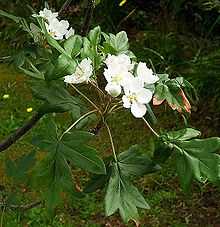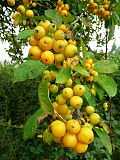Malus trilobata
| Malus trilobata | |
|---|---|
 | |
| Scientific classification | |
| Kingdom: | Plantae |
| (unranked): | Angiosperms |
| (unranked): | Eudicots |
| (unranked): | Rosids |
| Order: | Rosales |
| Family: | Rosaceae |
| Genus: | Malus |
| Species: | M. trilobata |
| Binomial name | |
| Malus trilobata C.K.Schneid. | |
Malus trilobata, the Lebanese wild apple, erect crab apple or three-lobed apple tree, is a species in the family Rosaceae in the genus Malus. [1] Some authorities place it in the segregate genus Eriolobus, as Eriolobus trilobatus.
Distribution
Malus trilobata is endemic to Lebanon, with surviving trees in the Mount Lebanon Range, at altitudes of 1,000–1,500 metres (3,300–4,900 ft). [1]
The last remaining forest community of the endemic wild apple in the country, that is protected, is in Horsh Ehden Nature Reserve.
Description
Malus trilobata has an upright habit with horizontal branching and a mature size of 15 metres (49 ft) height by 7 metres (23 ft) width. [2]
The leaves are maple-like and deeply three-lobed. They turn from orange to red to deep purple in the fall. [1]
The tree blooms during April and May producing white flowers and yellow fruits.
References
- "Les Principaux Arbres du Liban"; La Fascicule des Essences Forestieres du Liban. Projet d'assistance a la protection de la couverture vegetale au Liban (Ministry of Agriculture and European Union); 1999.
- Zahreddine, H.G., Barker, D.J., Quigley, M.F., Sleem, K., Struve, D.K. (2007b); "Patterns of woody plant species diversity in Lebanon as affected by climatic and soil properties"; Lebanese Science Journal 8:21–44.
| |||||||||||||||||
